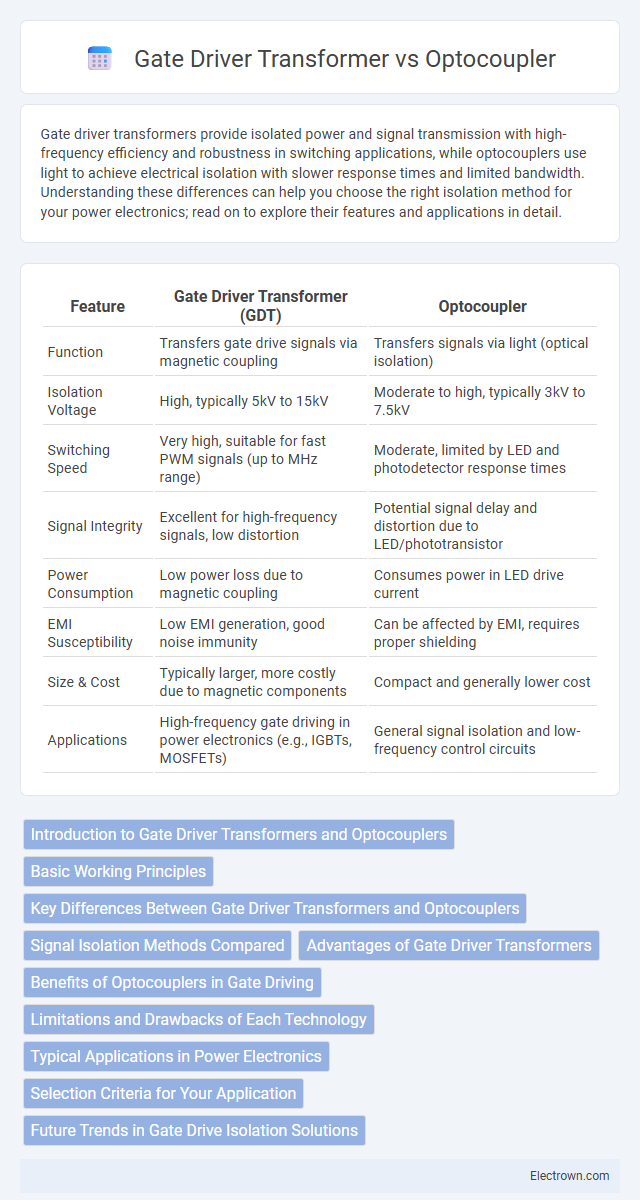Gate driver transformers provide isolated power and signal transmission with high-frequency efficiency and robustness in switching applications, while optocouplers use light to achieve electrical isolation with slower response times and limited bandwidth. Understanding these differences can help you choose the right isolation method for your power electronics; read on to explore their features and applications in detail.
Table of Comparison
| Feature | Gate Driver Transformer (GDT) | Optocoupler |
|---|---|---|
| Function | Transfers gate drive signals via magnetic coupling | Transfers signals via light (optical isolation) |
| Isolation Voltage | High, typically 5kV to 15kV | Moderate to high, typically 3kV to 7.5kV |
| Switching Speed | Very high, suitable for fast PWM signals (up to MHz range) | Moderate, limited by LED and photodetector response times |
| Signal Integrity | Excellent for high-frequency signals, low distortion | Potential signal delay and distortion due to LED/phototransistor |
| Power Consumption | Low power loss due to magnetic coupling | Consumes power in LED drive current |
| EMI Susceptibility | Low EMI generation, good noise immunity | Can be affected by EMI, requires proper shielding |
| Size & Cost | Typically larger, more costly due to magnetic components | Compact and generally lower cost |
| Applications | High-frequency gate driving in power electronics (e.g., IGBTs, MOSFETs) | General signal isolation and low-frequency control circuits |
Introduction to Gate Driver Transformers and Optocouplers
Gate driver transformers provide galvanic isolation and high-speed signal transfer for switching power devices in applications requiring efficient pulse transmission. Optocouplers use LED and photodetector pairs to achieve electrical isolation while converting electrical signals into optical signals, suitable for noise-immune data communication. Understanding the differences in speed, isolation methods, and application environments helps you choose the right component for reliable gate control and signal isolation.
Basic Working Principles
Gate driver transformers utilize magnetic coupling to transfer energy and signals for driving power transistors, offering galvanic isolation and high-frequency operation without direct electrical connection. Optocouplers employ light emission and detection, using an LED and photodetector pair to electrically isolate input and output while transmitting signals through optical means. Both devices provide isolation, but gate driver transformers excel in power transfer and high-speed switching, whereas optocouplers are preferred for low-frequency signal isolation.
Key Differences Between Gate Driver Transformers and Optocouplers
Gate driver transformers provide galvanic isolation and efficient high-frequency signal transmission for driving power transistors, while optocouplers use light to electrically isolate input and output signals, often resulting in slower switching speeds. Gate driver transformers excel in high-speed, high-power applications with superior noise immunity, whereas optocouplers are favored for simpler isolations needing lower bandwidth and easier integration. Your choice depends on factors like switching frequency, isolation requirements, and system complexity in power electronics designs.
Signal Isolation Methods Compared
Gate driver transformers use magnetic coupling to provide galvanic isolation, enabling high-frequency signal transmission with minimal delay and robust noise immunity. Optocouplers achieve electrical isolation through light signals, offering excellent noise rejection but often limited bandwidth and slower response time compared to gate driver transformers. Your choice depends on required switching speed, isolation voltage, and system noise environment, with transformers favoring high-speed, high-frequency applications and optocouplers suited for lower frequency or cost-sensitive designs.
Advantages of Gate Driver Transformers
Gate driver transformers provide galvanic isolation and high-frequency signal transfer, enabling efficient switching in power electronics with minimal noise interference. They are compact, support wide bandwidths, and can handle high voltage differentials, enhancing the performance and reliability of your power conversion systems. Unlike optocouplers, gate driver transformers offer superior speed and robustness in harsh electromagnetic environments.
Benefits of Optocouplers in Gate Driving
Optocouplers in gate driving provide superior electrical isolation between control and power circuits, enhancing safety and noise immunity. They enable precise signal transmission without direct electrical connection, reducing the risk of ground loops and interference in high-voltage applications. Your gate driver circuits benefit from simpler integration and reliable operation, especially in environments with significant electromagnetic disturbances.
Limitations and Drawbacks of Each Technology
Gate driver transformers exhibit limitations such as size constraints, core saturation risks at high frequencies, and potential signal distortion due to parasitic inductances, which can impact switching performance. Optocouplers face drawbacks including limited bandwidth, slower response times, and degradation of the LED-phototransistor components over time, leading to reduced isolation reliability. Both technologies also present trade-offs in terms of isolation voltage ratings and susceptibility to electromagnetic interference.
Typical Applications in Power Electronics
Gate driver transformers are typically used in isolated gate drive applications for high-frequency switching devices such as IGBTs and MOSFETs in power converters, inverters, and motor drives due to their ability to provide galvanic isolation and high transient immunity. Optocouplers are commonly employed in low to medium frequency applications like power supply feedback control and protection circuits, offering electrical isolation with simplified signal transmission but limited bandwidth. The choice depends on factors like switching frequency, isolation voltage, and signal fidelity required in power electronic systems.
Selection Criteria for Your Application
Gate driver transformers provide galvanic isolation and high-frequency signal transfer ideal for high-speed switching applications with stringent EMI requirements. Optocouplers offer electrical isolation using light transmission, suitable for low-speed switching and environments sensitive to electrical noise but with limited bandwidth. Selection depends on factors such as switching frequency, isolation voltage, propagation delay, and system electromagnetic interference tolerance tailored to your specific application needs.
Future Trends in Gate Drive Isolation Solutions
Gate driver transformers offer superior frequency response and galvanic isolation, making them ideal for high-efficiency power conversion, while optocouplers provide compact design and ease of integration in low to medium power applications. Emerging trends highlight the advancement of wide-bandgap semiconductor compatibility and integrated digital isolators, enhancing performance and reliability in future gate drive isolation systems. Your choice of isolation technology will increasingly depend on system power levels, switching speeds, and electromagnetic interference mitigation requirements.
gate driver transformer vs optocoupler Infographic

 electrown.com
electrown.com